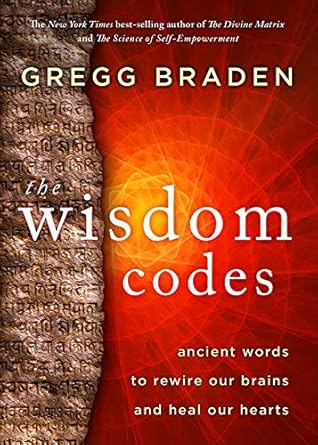More on this book
Community
Kindle Notes & Highlights
by
Gregg Braden
Read between
February 21 - February 21, 2021
we already have the power to rewire our brains on demand, and in doing so, to choose—to self-regulate—the way we respond to life’s extremes.
we hear the word-messages of our subconscious thoughts repeating at the dizzying rate of 60,000 to 80,000 times each day, according to scientific estimates.
words of our everyday language directly influence the way our brain “wires” itself when it comes to how we think, and even what we are capable of thinking about.
the language of the North American Hopi. Speakers of this language describe the events of everyday life without using—or even referencing—the experience of time. In other words, the Hopi language uses words that describe the present moment, and what’s happening in the moment, with no words to directly describe the past or future.
When the Hopi refer to lightning, their language describes it as a verb that’s occurring, rather than a noun for something that exists. They say the equivalent of “It is lightning-ing,” indicating that the lightning is in a state of being, rather than observing “the lightning” as a natural object. In a similar way, when considering the ocean, rather than describing a single wave as the noun the wave or a wave, the Hopi see the wave as part of an all-inclusive system that is present, alive, and happening in the moment.
When considering the entirety of creation, for example, they see a living universe of connectivity that emerged long ago from a primal state of harmony. Within this system of oneness, the Hopi view cooperation between people and within nature as everyday expressions of a universal harmony that extends throughout the cosmos. This life-affirming way of thinking stands in sharp contrast to the conventional scientific perspective that describes the universe as a “dead” system that emerged from a series of random and unbelievably fortunate cosmic events long ago.
New discoveries in biology, as well as other life sciences, now reveal that cooperation, not competition, is the fundamental rule of nature.
The implications of the word-life relationship are profound. It appears that the language we use—the words we choose to describe ourselves and share our thoughts, feelings, emotions, and beliefs—actually forms the framework for the unity or separation that we experience when we think and solve the problems of everyday life.
“A single word has the power to influence the expression of genes that regulate physical and emotional stress.” Additionally, Newberg and Waldman reveal a relationship between our words and our body that goes beyond the level of our genes, to impact our perception of reality itself.
They write, “Over time the structure of your thalamus will also change in response to your conscious words, thoughts, and feelings, and we believe that the thalamic changes affect the way in which you perceive reality.”
Our words influence the chemistry in our bodies, the neurons in our brains, and the way our neurons connect and “fire” to determine: How we think of ourselves and solve our problems What we are even capable of thinking about
For thousands of years, precise words and ritual phrases have been spoken from father to son, mother to daughter, shaman to shaman, and healer to healer. And from the time of the earliest writings, these are the messages that were preserved for future generations in the sacred scripts and mysterious glyphs that have withstood the test of time.
What we often perceive as separate issues are in reality different expressions of the same underlying issue. For example, while we commonly think of anger, jealousy, and criticism as separate issues to be dealt with one by one, each ultimately points to the same core issue: unresolved fear. By healing (resolving) our underlying fear, we dismantle the need for safety and the reasons why varied expressions of the same fear may be showing up in our lives.
the power of the cascade effect in relationships—the healing of many emotions through the resolution of a single core fear.
“When we see your prayers,” I began, “what are you doing in your body? When we see you tone and chant mantras for fourteen to sixteen hours a day on the outside, what is happening to you on the inside?”
“What you have seen is what we do to create the feeling in our bodies. The feeling is the prayer, and the words create the feeling!”
“Ask without hidden motive and be surrounded by your answer. Be enveloped by what you desire so that your joy may be full.”
When we allow ourselves to fully embrace what our spoken words mean on the deepest possible levels of awareness, they trigger the neurological and biological responses that reflect the intent
Though the times have changed, we’re not so different from our ancestors in how we respond when life’s tests arrive at our doorsteps. We still reel from the loss of our loved ones. We still ask for protection when we’re afraid. We still seek guidance when we make difficult choices. And like our ancestors, we still can benefit from the wisdom
sometimes we feel the need to protect ourselves from forces that are not so obvious, because we can’t see them. Unseen forces can be more difficult to remedy. These are the forces that our ancestors addressed through the use of wisdom codes that shift our perspective, and in turn, the chemistry of our bodies,


